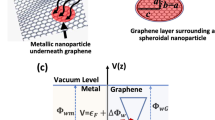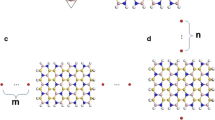Abstract
Graphene oxide (GO) was prepared using the improved Hummer method, and mono-dispersed manganese cobalt nickel oxide (MCN) semiconductor nanometer particles were synthesized and coated with GO. Under 980-nm infrared laser excitation, this novel hybrid material demonstrated nanometer-scale surface plasmon resonance. The same mechanism has previously only been reported in good conductors. Although the MCN semiconductor is a negative temperature coefficient material, it can realize the same effect as a good conductor. The experimental data indicated that the hybrid material absorbed infrared laser photothermal energy with a transformation efficiency more than fourfold larger than that of pure mono-disperse MCN semiconductor nanopowder. The chain heat conductivity velocity of the hybrid material compares favorably with that of metal in that it alters the laser radiation energy heat transfer method on the surface. The hybrid material is one new kind of photothermal energy transfer material by new chain nanoscale surface plasmon mechanical, it can absorb sunlight and ultra-red light totally, and is one excellent energy transform and absorb material for sunlight.











Similar content being viewed by others
References
Hummers S, Hoffman R (1958) Preparation of graphitic oxide. J Am Chem Soc 80(6):1339
Marcano DC, Kosynkin DV, Berlin JM et al (2010) Improved synthesis of graphene oxide [J]. ACS Nano 4(8):4806–4814
Warner JH, Ru¨ mmeli MH, Ge L, Gremming T, Montanari B, Harrison NM, Bu¨ chner B, Briggs GAD (2009) Nat Nanotechnol 4:500–504
Li D, Mueller MB, Gilje S, Kaner RB, Wallace GG (2008) Process-able aqueous dispersions of graphenenanosheets. Nat Nanotechnol 3:101–105
Yokoyama T, Abe Y, Meguro T, Komeya K, Kondo K, Kaneko S (1996) Preparation and electrical properties of sintered bodies composed of mono-phase spinel Mn(2-x)Co2Ni(1-x)O4 (0 < x < 1) derived from rock-salt-type oxides. J Appl Phys 35:5775–5780
Novoselov KS, Geim AK, Morozov SV, Jiang D, Zhang Y, Dubonos SV, Grigorieva IV, Firsov AA (2004) Science 306:666
Mkhoyan K, Contryman A, Silcox J, Stewart D, Eda G, Mattevi C, Miller S, Chhowalla M (2009) Atomic and electronic structure of graphene-oxide. Nano Lett 9:1058–1063
Novoselov K, Geim A, Morozov S et al (2004) Electric field effect in atomically thin carbon films [J]. Science 306:666–669
Nikolic MV, Paraskevopoulos KM, Aleksic’ OS et al (2007) Far infrared reflectance of sintered nickel manganite samples for negative temperature coefficient thermistors. Mater Res Bull 42:1492–1498
Dreyer DR, Park S, Bielawski CW, Ruoff R (2010) The chemistry of graphene oxide. Chem Soc Rev 39:228–240
Ostrovsky PM, Gornyi IV, Mirlin AD (2006) Electron transport in disordered graphene. Phys Rev B 74:235443
Ferrari AC et al (2006) Raman spectrum of graphene and graphene layers. Phys Rev Lett 97:187401
Grigorenko AN, Polini M, Novoselov KS (2012) Graphene plasmonics. Nat Photon 6:749–758
Hontoria- Lucas C, Lo’ pez-Peinado A, Lo’pez-Gonza’lez J, Rojas-Cervantes M, Martı’n-Aranda R (1995) Study of oxygen-containing groups in a series of graphite oxides: physical and chemical characterization. Carbon 33:1585–1592
Eda G, Fanchini G, Chhowalla M (2008) Large-area ultrathin films of reduced graphene oxide as a transparent and flexible electronic material. Nat Nanotechnol 3:270–274
Woodruff DP (ed)"The chemical physics of solid surfaces", Vol. 10, Elsevier, 2002
de García Abajo FJ (2014) Graphene plasmonics: challenges and opportunities. ACS Photonics 1(3):135–152
de Csete Györgyfalva GDC, Reaney IM (2001) Decomposition of NiMn2O4 spinel: an NTC thermistor material[J]. J Eur Ceram Soc 21:2145–2148
Pandey D, Reifenberger R, Piner R (2008) Scanning probe microscopy study of exfoliated oxidized graphene sheets. Surf Sci 602(9):1607–1611
Gao YQ, Huang ZM, Hou Y, Wu J, Ge YJ, Chu JH (2009) Optical properties of Mn1.56Co0.96Ni0.48O4 films studies by spectroscopic ellipsometry. Appl Phys Lett 94
Callaway J (1974) Quantum theory of the solid state. Academic Press, New York, pp 516–520
Ozbay E (2006) Plasmonics: merging photonics and electronics at nanoscale dimensions. Science 311(5758):189–193
Polman A, Atwater HA (2005) Plasmonics: optics at the nanoscale. Mater Today 8:56
Oppens FHL, Chang DE, de García Abajo FJ (2011) Graphene plasmonics: a platform for strong light-matter interactions. Nano Lett 11:3370–3377
Yan H et al (2012) Tunable infrared plasmonic devices using graphene/insulator stacks. Nat Nanotechnol 7:330–334
Yan H et al (2013) Damping pathways of mid-infrared plasmons in graphene nanostructures. Nat Photon 7:394–399
Brar VW, Jang MS, Sherrott M, Lopez JJ, Atwater HA (2013) Highly confined tunable mid-infrared plasmonics in graphene nanoresonators. Nano Lett 13:2541–2547
Low T, Avouris P (2014) Graphene plasmonics for terahertz to mid-infrared applications. ACS Nano 8:1086–1101
Acknowledgments
Mr. Peng Zhang [1], Ms. Didi Luo [1], Ms. Yanling Ai, Dr. Mingzhen Wang, Dr. Xiaowei Yin, Ms. Huan Li, Mr. Kun Sun, (Northwestern Polytechnical University), Mr. Xinhua Liang, and Dr. Jingyan Liu (Xi’an Non-ferrous Metal Institute). Dr. Yong Wang (Xi’An Jiaotong University, Xi’An, Shaanxi Province). All of them contributed to experimental auxiliary work.
Author information
Authors and Affiliations
Corresponding author
Rights and permissions
About this article
Cite this article
Su, L., Wan, C., Yang, P. et al. Hybrid Graphene Oxide and NTC Semiconductor Material Absorbs and Transform Light Energy via a Novel Surface Nanoscale Plasmon Mechanical. Plasmonics 11, 53–60 (2016). https://doi.org/10.1007/s11468-015-0013-4
Received:
Accepted:
Published:
Issue Date:
DOI: https://doi.org/10.1007/s11468-015-0013-4




